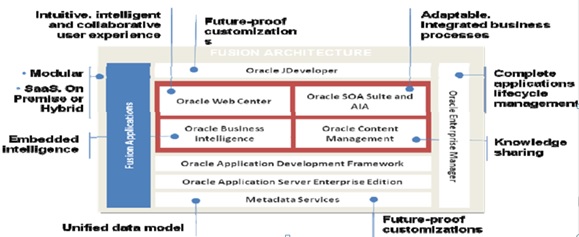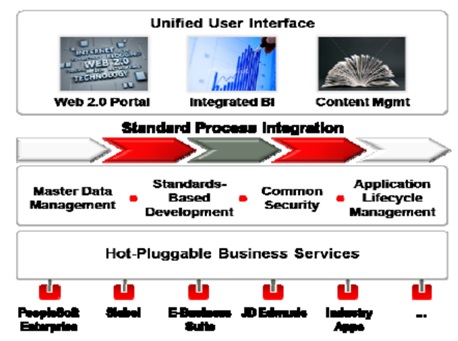By David McNeil and Jose Bastidas, MBA, PMP
Fusion is the Oracle brand of products grouped into two categories; Oracle Fusion Middleware (OFM) and Oracle Fusion Applications (OFA). Oracle created the Oracle Fusion suite to answer the need for more user-oriented tools and applications to simplify day-to-day activities and provide a more robust integration capability enabling users the ability to retrieve valuable reports and information in real-time from multiple sources like an ERP, OBIEE, the Web, third party applications, and even social media sites. The products grouped under the OFM category are oriented to provide an integration platform between different applications leveraging the concept of Service Oriented Architecture. The products grouped under the OFA category are the Oracle applications, with a new and improved User Interface that allows end users to process real-time ERP transactions more efficiently. Since most of the new features available today are part of the OFM group, we will try to focus this article on those.
Oracle Fusion Middleware comprises many Oracle software products and tools that can be leveraged in many ways. The OFM products and tools include Enterprise Application Server, Integration and Process-Management tools (BPEL, BAM, etc.), Application Development Tools (SOA), Business Intelligence, Systems Management tools, User interaction and Portal Tools, Content Management capability, Identity Management applications, Grid Infrastructure, and Performance Management.
Let me highlight some key features we found most beneficial to our customers. As shown in Figure 1, the pillars that anchor the Oracle Fusion Model are; Oracle SOA Suite (Service Oriented Architecture), AIA (Application Integration Architecture), and Oracle Business Intelligence.
The Oracle SOA Suite and the AIA enable access to “plug-ins” that connect or integrate Fusion Middle Ware with Oracle and Non-Oracle applications such as PeopleSoft, Siebel CRM, E-Business Suite, JD Edwards, or other Industry specific applications. This is done using Application Management packs, as shown in Figure 2. Oracle Business Intelligence then provides access to easy-to-use reporting tools that users can use to create reports from data residing across all these applications.
OFM also provides a state-of-the-art development framework called Oracle Application Development Framework (ADF). ADF is an end-to-end Java EE framework that simplifies application development by providing out-of-the-box infrastructure services and a visual and declarative development experience. ADF allows the creation of customizations by providing a metadata layer that describes the application’s behavior. The application’s behavior is defined using definitions such as inherent business logic, the user interface, the business rules, and the business processes. Changes to applications using ADF are made to the metadata layer, which is built based on graphical flows, dragging and dropping tables, functions, and rules and not directly in the code. This enables developers to create/change customizations more quickly and efficiently as they are integrated into the database and protected during an upgrade. Another advantage of using ADF for developing customizations is that these can be displayed on mobile devices thanks to ADF Mobile. ADF Mobile uses HTML5, Java, and other components to reach enterprise applications like Java Server Faces (JSF). This allows developers to create iOS and Android-compatible applications for regular browsers and tablet-based ones.
Oracle Application Server Enterprise Edition with Oracle Grid Computing technology allows users to manage new hardware based on applications and storage needs, avoiding having dedicated servers for each specific application. This allows multiple applications to share computing infrastructure, resulting in greater flexibility, cost, power, efficiency, performance, scalability, and availability.
Oracle Master Data Management allows consolidating Master Data avoiding data redundancy, allowing easy maintenance of the information, and providing integrity and consistency across multiple applications.
We can see that when Oracle named this technology suite, Fusion, they were thinking of a platform that allows the fusion of the best Oracle technology available in the market, an easy-to-use configuration tool, and a much sought-after easy-to-use and flexible end-user layer.
Although Fusion has been on the market for the last seven years, it has only been just the previous five years that it has reached the level of maturity that companies are looking for when considering a middleware application. This technology becomes a critical cog as companies look to integrate their existing applications with new mobile applications and as they look to upgrade to the latest release of Oracle Applications.
As you embark on your specific project, you will soon find out, as with many new technologies, that not many implementation partners like Project Partners have the experience required for a Fusion implementation. However, project Partners has the resources and expertise across industries to help you achieve the full potential of Oracle Fusion Middleware, Oracle Fusion Applications, and Oracle E-Business Suite R12 to enable you to exceed the desired ROI of your project.

